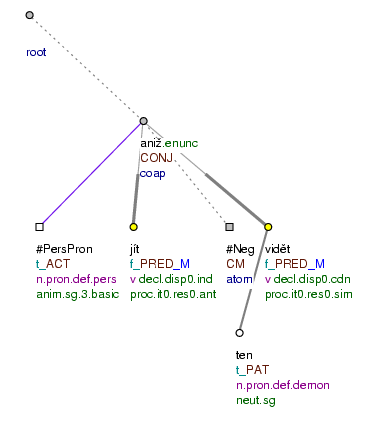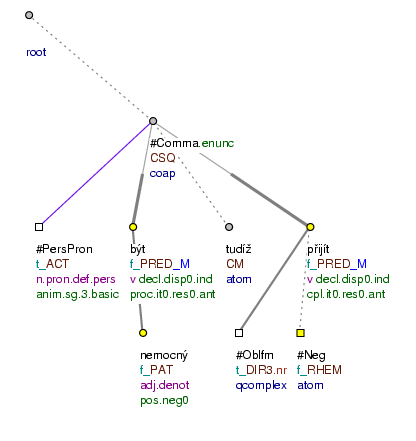Basic connectives. The basic (coordinating) connectives with the meaning of the ADVS functor are:
| ale | Vypadalo to, že bude hezky, ale začalo pršet. (=The weather looked nice but then it started raining) |
avšak (t_lemma=však) |
Obce chtějí podnítit cestovní ruch, avšak zároveň chránit citlivou ekologickou strukturu v oblasti. (=They want to support tourism, but they also want to protect the environment) |
| jenže | Měl bych se více věnovat dětem, jenže na to nemám čas. (=I should give more time to my children but I don't have enough time) |
| leč | Naslouchal pozorně, leč nic se neozvalo. (=He was listening carefully but he didn't hear anything) |
| nicméně | Řekl, že přijde, nicméně nepřišel. (=He had promised to come, however, he didn't come) |
| nýbrž | Sekulární donátor už není vlastníkem kostela, nýbrž pouhým patronem. (=The donor is not the owner of the church, only its patron) |
| ovšem | Může tak scenerii zpestřovat, nikoliv ovšem vytvářet. (=It can improve the scenery, but it cannot create it) |
| však | Tento dům jí byl vrácen, obžaloba však tvrdí, že jej získala podvodem. (=She got the house back but the prosecutor says...) |
Some other connectives. There are also other connectives with the ADVS meaning; e.g.:
| a | V dalších řádcích nebude odkaz na žádný zákon, a přesto půjde o záležitost nanejvýš aktuální. (=In the following, there is no reference to a law, and still the topic is highly relevant) |
| aniž | Dostal odměnu, aniž se o ni zasloužil. (=He was rewarded without deserving it) |
| punctuation | Přijel do Prahy, nikoli do Brna. (=He came to Praha, not to Brno) |
NB! The connective aniž negates the proposition in the second clause, therefore, a node for the negation (a node with the t-lemma substitute #Neg and the CM functor) is inserted to the clause. See also Section 5.4.1.1, "Constructions with the connectives "což", "přičemž", "načež", "pročež", "začež", "aniž"".
Conjunction modifiers. Coordinating conjunctions are often combined with other expressions that modify their meaning (see Section 16.1.2, "Conjunction modifiers"). Typical conjunction modifiers cooccuring with the ADVS functor are:
-
restrictors.
For example: vůbec, jen, zejména etc.
Example:
Koupil všechno možné, ale.
ADVSvůbec.CMnekoupil to důležité. (=He bought all kinds of things but he didn't buy the important ones at all) -
negating conjunction modifiers.
For example: ne, nikoli etc.
Example:
Koupil chleba, ale.
ADVSne.CMmléko. (=He bought bread but not milk) -
other conjunction modifiers.
přece Vypadalo to, že bude hezky, a přece začalo pršet. (=The weather looked nice, and still it started raining) přesto O výrobek by byl zájem, přesto však nemáme výrobce. (=People would be interested in the product but still there is no producer) sice O tom se sice občas píše v novinách, ale ve skutečnosti tomu tak nebývá. (=They write about it in newspapers but in reality it is different) zato Já jsem ji nepoznal, ale zato ty jsi ji znal velice dobře. (=I never met her but then you knew her very well) NB! The conjunction modifier sice can be found with appositions, too. For more on that see Section 12.2.1, "Borderline cases with the
APPSfunctor".
Contextualizers. Coordinating conjunctions can be combined with other conjunction modifiers, too, esp. with so called contextualizers.
Examples:
O výrobek by byl zájem, přesto.CM však.ADVS ještě.CM nemáme výrobce. (=People would be interested in the product but still there is no producer yet) Fig. 7.63
Nebyl to ani.CM Petr, ale.ADVS též.CM ani.CM Pavel. (=It wasn't Petr but it wasn't Pavel either)
Figure 7.63. The ADVS functor
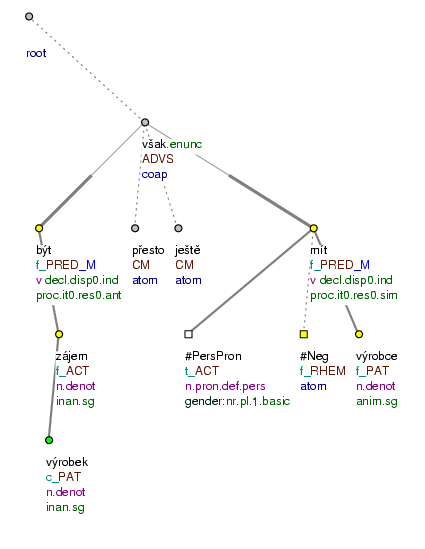
O výrobek byl zájem, přesto však ještě nemáme výrobce. (=lit. In product was interest, still though yet (we) not_have producer)
Borders with other functors for coordination (esp. CONJ). A number of coordinating connectives express primarily the meaning of the ADVS functor. The ADVS functor gets closer to the meanings of other functors (esp. CONJ; see Section 12.1.3, "CONJ") if an ambiguous connective (e.g. aniž) is used, or if a connective reserved for a different type of paratactic structures is used (e.g. a), or if expressed asyndetically.
If an ambiguous connective is used, it is necessary to consider the relation between the connected propositions (modifications) carefully. Cf.:
-
Dostal odměnu, aniž.
ADVS(= ale ne) se o ni zasloužil (=He was rewarded without deserving it). -
Šel, aniž.
CONJ(= přičemž ne) viděl lidi kolem sebe. (=He was walking without seeing the people around)
If a connective reserved for a different meaning is used, it only gets the ADVS functor if it is clear that it carries the meaning; this can be made clear e.g. by appropriate conjunction modifiers. If it is not quite clear that the ADVS functor should be assigned, the root node of the paratactic structure gets the functor that is assigned to the connective by default. For example, the conjunction a (although primarily expressing the CONJ meaning) can also be assigned the ADVS functor if it connects two conflicting propositions (modifications). Cf.:
-
Slíbil, že přijde, a.
CONJpřišel (=He had promised to come and he did come). -
Slíbil, že přijde, a.
ADVSnepřišel (=He had promised to come, and he didn't come). -
Slíbil, že přijde, a.
ADVSpřece .CMnepřišel. (=He had promised to come and still he didn't come)
A similar situation arises when the clauses or modifications are connected asyndetically. Asyndetic connection is used usually with the CONJ interpretation; however, if two conflicting propositions (modifications) are connected asyndetically, the root node of such a paratactic structure gets the ADVS functor. Cf.:
-
Přijel do Prahy, [
#Comma.ADVS] nikoli.CMdo Brna (=He came to Praha, not to Brno).
Border with the CONFR functor. Semantically, the ADVS functor is very close to the CONFR functor (see Section 12.1.2, "CONFR"). For more on this border see Section 12.1.2.1, "Borderline cases with the CONFR functor".
Border with the GRAD functor. Conjunctions used primarily for expressing the ADVS meaning (ale, nýbrž) are also used for gradation (GRAD; see Section 12.1.7, "GRAD"). For more on this see Section 12.1.7.1, "Borderline cases with the GRAD functor".
Border with the CNCS functor. Semantically, the ADVS functor is very close to the CNCS functor, too (see Section 5.3, "CNCS"). For the relation between the ADVS and CNCS functors, see Section 5.3.1, "Borderline cases with CNCS the functor ".
Comparison based on confrontation means that one fact (figure) stands out whereas another fact serves as a background. CONFR only concerns clausal coordination. The coordinated clauses are typically parallel in their syntactic structure.
Basic connectives. The basic (coordinating) connective with the meaning of the CONFR functor is:
| kdežto | Bristol je v Anglii, kdežto Glasgow je ve Skotsku. (Bristol is in England, whereas Glasgow is in Scotland) |
Some other connectives. There are also other connectives with the CONFR meaning; e.g.:
| a | Svobodní mládenci mívají nepořádek kolem sebe, a ženatí naopak mívají nepořádek v duši. (=Bachelors often have a mess all around them and married men, on the other hand, have a mess in their souls) |
| ale | Svobodní mládenci mívají nepořádek kolem sebe, ale ženatí naopak mívají nepořádek v duši. (=Bachelors often have a mess all around them but married men, on the other hand, have a mess in their souls) |
| punctuation | Kontrolní odběry před velkými sportovními událostmi se už dávno dělat nesmějí, naopak mimosoutěžní odběry ano. (=Control samples before big competitions cannot be taken any more, the ones not taken in competitions, on the other hand, can) |
Conjunction modifiers. Coordinating conjunctions are often combined with other expressions that modify their meaning (see Section 16.1.2, "Conjunction modifiers"). A typical conjunction modifier cooccuring with the CONFR functor is:
| naopak | Kontrolní odběry před velkými sportovními událostmi se už dávno dělat nesmějí, naopak mimosoutěžní odběry ano. (=Control samples before big competitions cannot be taken any more, the ones not taken in competitions, on the other hand, can) |
Examples:
Svobodní mládenci mívají nepořádek kolem sebe, kdežto.ADVS ženatí naopak.CM mívají nepořádek v duši. (=Bachelors often have a mess all around them whereas married men, on the other hand, have a mess in their souls) Fig. 7.64
Figure 7.64. The CONFR functor
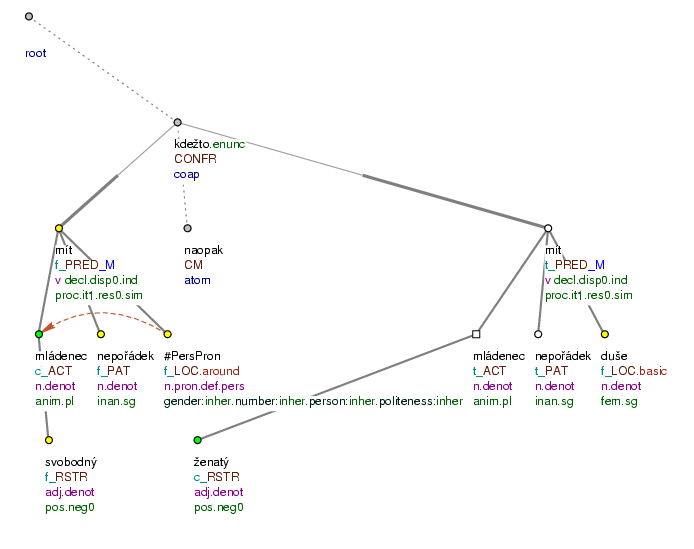
Svobodní mládenci mívají nepořádek kolem sebe, kdežto ženatí naopak mívají nepořádek v duši. (=lit. Bachelors - have mess around themselves whereas married on_the_contrary have mess in soul)
Border with the ADVS functor. Semantically, the CONFR functor is very close to the ADVS functor (see Section 12.1.1, "ADVS"). Confrontation (CONFR) is involved whenever two facts are put into a sharp contrast. The clauses are typically parallel in their syntactic structure; moreover, it is always a clausal (not constituent) coordination. An adversative relation (ADVS) is involved if the second proposition (modification) contradicts the expectation following from the first proposition (modification). Sometimes, the borderline between these two meanings is unclear and difficult to find; for the annotation, it is useful to rely on the used connective. A paratactic connection with the conjunction ale is analyzed as having the ADVS meaning, whereas a paratactic connection realized by kdežto is analyzed as having the CONFR meaning. Cf.:
-
Bristol je v Anglii, kdežto.
CONFRGlasgow je ve Skotsku. (=Bristol is in England, whereas Glasgow is in Scotland) -
Bristol je v Anglii, ale.
ADVSGlasgow je ve Skotsku. (=Bristol is in England but Glasgow is in Scotland)
Border with the CONTRD and COND functors. Confrontation can also be expressed by means of the subordinating conjunction zatímco (CONTRD; see Section 9.2, "CONTRD"). Confrontation is sometimes also interpreted in sentences with subordinating conjunctions jestliže, -li and když, too (COND; see Section 5.4, "COND"). For more on the border between the functors CONFR, CONTRD and COND see Section 9.2.1, "Borderline cases with the functor CONTRD" and Section 5.4.2, "False dependent conjunctional clauses".
Basic connectives. The basic (coordinating) connectives with the meaning of the CONJ functor are:
| a | Mezi smysly patří zrak a sluch a hmat. (=Eyesight and hearing and touch belong to the senses) |
| i | žáci i žákyně (=male as well as female pupils) |
| jak - tak | Vyniká jak svědomitostí, tak houževnatostí. (=She stands out due to her thoroughness, as well as her stringiness) |
| asyndetic connection | Kreslíme tužkou, malujeme pastelkami. (=We draw with a pencil, colored pencils) |
Some other connectives. There are also other connectives expressing the CONJ meaning; e.g.:
| ani | Ve Francii není ani vítězů ani poražených. (=There are neither winners, nor defeated in France) |
| aniž | Šel, aniž by to viděl. (=He was walking without seeing it) |
| což | Firma nechce přijímat žádné další zaměstnance, což je pochopitelné. (=The company doesn't want to accept any new employees, which is understandable) |
| či | V minulé sezóně spolupracoval s touto firmou či s agenturním souborem Brak. (=Last season I cooperated with this company or with Brak) |
| jako | Ochutnal Plzeň, Krušovice, stejně jako Budvar. (=He tried Plzeň, Krušovice, as well as Budvar) |
| jakož | Petr, Pavel, jakož i Honza (=Petr, Pavel as well as Honza) |
| načež | Vyšel z domu, načež začala bouřka. (=He left the house whereupon the storm broke out) |
| nebo | Posílají tam nemocné nebo raněné. (=They send the ill or injured ones there) |
| přičemž | Šel, přičemž neviděl. (=He was walking and didn't see anything) |
NB! The connective aniž negates the predicate in the second clause (Šel, aniž by to viděl. (=He was walking without seeing it) = Šel a neviděl to. (=He was walking and didn't see it)); a node with the t-lemma substitute #Neg and the CM functor is inserted into the subtree for the second clause. See also Section 5.4.1.1, "Constructions with the connectives "což", "přičemž", "načež", "pročež", "začež", "aniž"".
Example:
Šel, aniž.CONJ by to{#Neg.CM} viděl. (=He was walking without seeing it) Fig. 7.65
NB! Also some constructions with the connective což are analyzed by means of the CONJ functor (see also Section 5.4.1.1, "Constructions with the connectives "což", "přičemž", "načež", "pročež", "začež", "aniž"").
Conjunction modifiers. Coordinating conjunctions are often combined with other expressions that modify their meaning (see Section 16.1.2, "Conjunction modifiers"). Typical conjunction modifiers with the CONJ functor are stejně and podobně (modifying jako). Other conjunction modifiers cooccuring with the CONJ functor are e.g. jednak and respektive; however, also other types of relation than CONJ between the connected propositions (modifications) are possible with these conjunction modifiers.
| podobně | Ochutnal Plzeň, Krušovice, podobně jako Budvar. (=He tried Plzeň, Krušovice and similarly Budvar) |
| stejně | Ochutnal Plzeň, Krušovice, stejně jako Budvar. (=He tried Plzeň, Krušovice, as well as Budvar) |
| jednak | Na táboře se děti jednak zotavily, jednak se naučily mnoha novým věcem. (=The children recovered and learned a lot of new stuff as well) |
| respektive | Letos v prvním čtvrtletí činily krátkodobé sazby v USA 3.0 a dlouhodobé 6.3 procenta, v Německu 5.8, respektive 5.6%. (=...in Germany it was 5.8, or rather 5.6%) |
NB! The conjunction modifier jednak cooccurs primarily with CONJ; however, if the proposition of the second clause is graded w.r.t. the first clause (esp. if this is made clear by an appropriate restrictor) the root node of the paratactic structure can also be assigned the GRAD functor (see also Section 12.1.7, "GRAD").
NB! The conjunction modifier respektive has three meanings. It can be also used with the DISJ functor or with appositions. See also Section 12.2.1, "Borderline cases with the APPS functor".
Contextualizers. Coordinating conjunctions (with the CONJ functor) can be combined with other conjunction modifiers, too, esp. with so called contextualizers.
Examples:
Je posuzována jeho příčetnost a.CONJ dále.CM , zda není nebezpečný. (=They are considering his sanity and further whether he's not dangerous)
Kreslíme tužkou, [#Comma.CONJ] také.CM malujeme pastelkami. (=We draw with a pencil and also with colored pencils)
Kreslíme tužkou a.CONJ k tomu.CM ještě.CM malujeme pastelkami. (=We draw with a pencil and moreover with colored pencils)
Vidím dnes potřebu určité liberalizace živnostenského zákona a.CONJ pak.CM kompletizaci právního rámce. (=There is a need of liberalization and then..)
Okamžitě mě odvezli do Bartolomějské a.CONJ potom.CM ještě.CM několikrát do Konviktské a Ruzyně. (=First... and then also...)
Borders with other functors for coordination. The connectives used for simple conjunction are also used for expressing other kinds of relation within paratactic structures (esp. when combined with conjunction modifiers). In case of asyndetic connection and when the conjunctions a, i, ani are used, it is necessary to decide what kind of relation there is between the connected propositions (modifications). The CONJ functor is the default; a different functor is assigned if it is clear that some other relation than simple conjunction is involved (it is usually supported by the use of certain conjunction modifiers).
The CONJ functor gets close to other functors for connecting propositions (modifications) in paratactic structures also in those cases when an ambiguous connective or a connective reserved for another meaning is used. If an ambiguous connective is used (e.g. aniž) it is necessary to consider the relation between the two propositions carefully (see Section 12.1.1.1, "Borderline cases with the ADVS functor").
In cases in which a connective reserved for a different meaning (nebo) is used, the CONJ functor is only assigned if it is clear that it really is a case of simple conjunction. If it is not quite clear that the CONJ functor should be assigned, the root node of the paratactic structure gets the functor that is assigned to the connective by default.
Border with the ADVS functor. For the borderline cases between the CONJ and ADVS functors (esp. the conjunction a or punctuation), see Section 12.1.1.1, "Borderline cases with the ADVS functor".
Border with the CSQ functor. For the borderline cases between the CONJ and CSQ functors (esp. the conjunction a and načež), see Section 12.1.5.1, "Borderline cases with the CSQ functor".
Border with the GRAD functor. For the borderline cases between the CONJ and GRAD functors (esp. the conjunction a, ani or punctuation), see Section 12.1.7.1, "Borderline cases with the GRAD functor".
Border with the DISJ functor. For the borderline cases between the CONJ and DISJ functors (esp. the conjunction nebo and či), see Section 12.1.6.1, "Borderline cases with the DISJ functor".
Border with the CONTRA functor. For the borderline cases between the CONJ and CONTRA functors (the use of a dash), see Section 12.1.4.1, "Borderline cases with the CONTRA functor".
Border with the APPS functor. The CONJ functor is semantically close to the functor for apposition, too, the APPS functor. See also Section 12.2.1, "Borderline cases with the APPS functor".
Functors bordering as the result of the multifunctional conjunction "jako". The CONJ functor can get very close to the APPS functor (see Section 12.2, "Functor for apposition (APPS)"), and even the CPR (see Section 6.2, "CPR") and COMPL (see Section 11, "Functor for the predicative complement (COMPL)") functors. This is caused by the fact that the conjunction jako carries the meaning of all these functors. For more details see Section 17.4, "The conjunctions "než" and "jako"".
- Definition of the
CONTRAfunctor -
The
CONTRAfunctor is assigned to the root nodes of such paratactic structures in which two equal entities (never propositions) are represented as fighting, opposing each other.
Forms. The meaning of the CONTRA functor is usually expressed by the prepositions kontra and versus. When two subjects are connected by means of these prepositions, this has the form of a paratactic structure: the root node of the paratactic structure is the node representing one of the prepositions. Often, just a dash is used in place of kontra or versus. If this is the case, the dash gets the CONTRA functor (t_lemma=#Dash
The most common forms are, then:
| kontra | akademie věd kontra vysoké školství (=Academy of Science contra universities) |
| versus | Bukač versus Hlinka očima Jana Horáka (=Bukač versus Hlinka) |
dash (t_lemma=#Dash) |
utkání Rusko - Švédsko (=Russia - Sweden) |
Examples:
Na veřejnosti je tato otázka vnímána jako spor Klaus versus.CONTRA Zieleniec. (=Klaus vs. Zieleniec) Fig. 7.66
utkání Sparta - [#DashCONTRA] Slavia bylo zahájeno. (=the Sparta - Slavia match has started) Fig. 7.67
Figure 7.66. The CONTRA functor
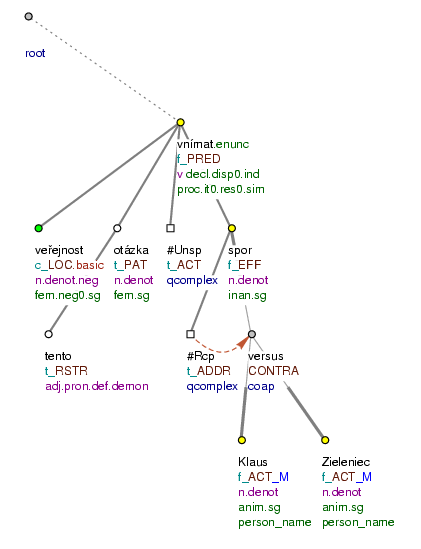
Na veřejnosti je tato otázka vnímána jako spor Klaus versus Zieleniec. (=lit. In public is this issue perceived as conflict Klaus vs. Zieleniec)
Figure 7.67. The CONTRA functor
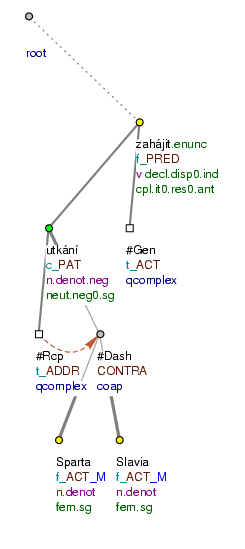
Utkání Sparta - Slavia bylo zahájeno. (=lit. Match Sparta - Slavia was started)
Borders with other functors (esp. CONJ). The CONTRA functor is only marginal. It has a very specific meaning, contained directly in the conjunctions kontra and versus. Apart from kontra and versus, the CONTRA functor is only assigned to a dash in similar constructions.
If - instead of kontra or versus - the conjunction a is used in a similar context, the CONJ functor is to be assigned preferably (see Section 12.1.3, "CONJ"). If the conjunction a is used, the meaning of two subjects fighting, opposing each other is never unambiguously implied. Cases with the preposition proti are analyzed by means of the functors for expressing dependency relations.
Cf.:
-
Utkání Sparta versus.
CONTRASlavia skončilo 2 : 0. -
Utkání Sparta - [
#DashCONTRA] Slavia skončilo 2 : 0. -
Utkání Sparta a.
CONJSlavia skončilo 2 : 0. -
Utkání Sparty proti Slavii.
ADDRskončilo 2 : 0.
Basic (complex) connectives. The basic form of expressing the CSQ meaning is a connective consisting of the conjunction a (or just punctuation) and a conjunction modifier typical for CSQ (see Section 16.1.2, "Conjunction modifiers").
Typical conjunction modifiers cooccuring with the CSQ functor are:
| proto | Pracoval nezodpovědně, a proto dostal výpověď. (=His was irresponsible, therefore he was fired) |
| tak | Měl jsem hlad, tak jsem si vzal koláč. (=I was hungry, so I ate a cake) |
| tedy | Je to utajeno, a tedy chráněno. (=It is a secret, hence it is protected) |
| tudíž | Byl nemocný, a tudíž nepřišel. (=He was sick so that's why he didn't come) |
NB! The conjunction modifiers tedy and tudíž can also modify a conjunction for apposition (see Section 12.2.1, "Borderline cases with the APPS functor").
Example:
Byl nemocný, [#Comma.CSQ] tudíž.CM nepřišel. (=lit. (He) was ill, therefore not_came) Fig. 7.68
Some other connectives. There are also other connectives expressing the CSQ meaning; e.g.:
| čili | Vězně obvykle nevolají k telefonu, čili vám volat nemohla. (=They don't usually call prisoners to telephone, so she couldn't call you) |
| jinak | Bylo to velmi důležité, jinak bych možná už nikdy do kokpitu nevlezl. (=It was very important, otherwise I wouldn't get into the cockpit again) |
| načež | Špatně se učil, načež propadl u zkoušky. (=He didn't learn enough which is the reason why he failed) |
| pročež | Neudělal jsem to, pročež se nemusíš zlobit. (=I didn't do it so you don't have to be angry) |
| takže | Potřebujete jen 1/4 vody, takže sprcha vás stojí 0,46 Kč. (=You only need 1/4 of the water so a shower costs 0.46 Kc) |
For more on načež and pročež see Section 5.4.1.1, "Constructions with the connectives "což", "přičemž", "načež", "pročež", "začež", "aniž"". For more on takže see Section 5.4.2.1, "Constructions with the connectives "kdežto" and "takže"".
Contextualizers. Coordinating conjunctions (with the CSQ functor) can be combined with other conjunction modifiers, too, esp. with so called contextualizers.
Examples:
Pracoval nezodpovědně, a.CSQ proto.CM také.CM dostal výpověď. (=He was irresponsible and therefore he was also fired)
Pracoval nezodpovědně, a.CSQ zvláště.CM proto.CM také.CM dostal výpověď. (=He was irresponsible and especially for that reason he was also fired)
Pracoval nezodpovědně, a.CSQ tak.CM tedy.CM také.CM dostal výpověď. (=He was irresponsible and so he was also fired)
Borders with other functors for coordination (esp. CONJ). A number of complex (coordinating) connectives express the meaning of the CSQ functor unambiguously. The CSQ functor gets closer to the meanings of other functors (esp. CONJ; see Section 12.1.3, "CONJ") if an ambiguous connective (e.g. načež) is used, or if a connective reserved for a different type of paratactic structures is used (e.g. a).
If an ambiguous connective is used, it is necessary to consider the relation between the connected propositions (modifications) carefully. Cf.:
-
Špatně se učil, načež.
CSQpropadl u zkoušky. (=He wasn't learning properly, which is why he failed at the exam) -
Vyšel z domu, načež.
CONJzačala bouřka. (=He left the house whereupon the storm broke out)
If a connective reserved for a different meaning is used, it only gets the CSQ functor if it is clear that it really carries the meaning; this can be made clear e.g. by appropriate conjunction modifiers. If it is not quite clear that the CSQ functor should be assigned, the root node of the paratactic structure gets the functor that is assigned to the connective by default. For example, the conjunction a (although primarily having the CONJ meaning) can be assigned the CSQ functor if it connects two propositions (modifications) the second one of which is a consequence of the first; cf.:
-
Přitvrdíme, a.
CSQ(v důsledku toho) budeme do roka v EU (=We'll try harder and (as a consequence) we'll be in EU in one year).
Border with the REAS functor. For the relation to the REAS functor see Section 12.1.8.1, "Borderline cases with the REAS functor".
Border with the APPS functor. The conjunction modifiers tedy and tudíž can also modify a conjunction for apposition. See also Section 12.2.1, "Borderline cases with the APPS functor".
Border with the APPS and DISJ functors. For more on the conjunction jinak (which is used for the DISJ, CSQ and APPS functors) see Section 12.2.1, "Borderline cases with the APPS functor".
In case of strong disjunction (only one of the propositions can be true), the DISJ meaning is carried especially by the following pairs of conjunctions: buď - nebo, buď - či, or simply by nebo, či. In case of weak disjunction, apart from the conjunctions like nebo, či, a nebo, also conjunction modifiers like eventuálně, popřípadě, případně, respektive are often used, which makes the disjunction weaker.
Basic connectives. The basic (coordinating) connectives with the meaning of the DISJ functor are:
| anebo | Nejraději loví psy, ať už zatoulané, anebo ty s obojkem a známkou. (=They prefer to hunt dogs, either stray or those with dog collars) |
| ať - či | ať vítaný, či nevítaný (=welcome or not) |
| ať - nebo | Přenos vzduchem, ať jde o televizní signál, nebo o digitální data, zajišťují radiokomunikace. (=The air transimission, if it is the TV signal or digital data,...) |
buď - anebo (t_lemma=buď_nebo) |
Ve Slavii jsou buď mladí hráči, anebo ti, kteří dostávali příležitost sporadicky. (In Slavia, there are either young players or those who haven't had much opportunity to play) |
| buď - či | Vysloví se buď pro, či proti návrhu. (=They will be either for or against the proposal) |
| buď - nebo | Vysloví se buď pro, nebo proti návrhu. (=They will be either for or against the proposal) |
buďto - anebo (t_lemma=buď_nebo) |
Nadšenci pro akustické brnkání v přírodě se mohou pohroužit buďto do brožury Folk-bluesová kytara & harmonika, anebo do Toulavé country kytary. (=...either Folk-bluesová kytara or Toulavá country kytara) |
buďto - či (t_lemma=buď_či) |
Němci mají buďto špičkové jezdecké koně, či koně podprůměrné. (=Germans have either top quality, or rather bad horses) |
buďto - nebo (t_lemma=buď_nebo) |
Firma by je buďto mohla využívat sama, nebo je dále pronajímat jiným zájemcům. (=The company could either use them or rent them) |
| či | Mají, či nemají pravdu? (=Are they right, or not?) |
| nebo | Měl dvě možnosti - nechat se předstihnout, nebo způsobit havárii. (=He had two possibilities - to be outrun, or to cause a crash) |
Some other connectives. There are also other connectives that can have the DISJ meaning; e.g.:
| a | Slovensko, a případně Maďarsko (=Slovakia and possibly Hungary) |
| jinak | Hlavně se nebojte zariskovat, jinak dopadneme jako Sparta. (=Don't be afraid to take chances, otherwise we'll end up like Sparta) |
| punctuation | Slovensko, případně Maďarsko (=Slovakia, possibly Hungary) |
NB! If the connection is asyndetic or the conjunction a is used, the DISJ meaning arises only if a conjunction modifier typical for this meaning is used.
Conjunction modifiers. Coordinating conjunctions are often combined with other expressions that modify their meaning (see Section 16.1.2, "Conjunction modifiers"). Typical conjunction modifiers cooccuring with the DISJ functor are:
-
restrictors.
For example: vůbec, jen, zejména etc.
Example:
Udělej to všechno, nebo.
DISJjen.CMto, co stihneš. (=Do it all, or just what you can manage to do) -
other conjunction modifiers.
eventuálně Ti musí navíc přiložit daňové přiznání s dokladem o zaplacení daně, eventuálně peněžní deník a výpis z obchodního rejstříku. (=They have to submit also their tax return, possibly also...) popřípadě Na konzultaci musí přijít alespoň jeden z rodičů, popřípadě alespoň někdo z rodiny. (=At least one parent has to come, or at least a member of the family) případně Často se stane, že se obraz nevydraží, anebo případně vydraží za cenu nižší, než na jakou si prodejce myslí. (=It often happens that the painting is not sold or maybe it is but the price is lower) už O žádných tajných zprávách nevědí nic ti, kdo je běžně utajují ať už v Dejvicích, nebo v Pentagonu. (=They know nothing, if they are in Dejvice or Pentagon) respektive prodávající, respektive kupující (=the ones who sell, or the ones who buy) NB! The conjunction modifier respektive has three meanings. It can be also used with the
CONJfunctor or with appositions. See also Section 12.2.1, "Borderline cases with theAPPSfunctor".
Contextualizers. Coordinating conjunctions (with the DISJ functor) can be combined with other conjunction modifiers, too, esp. with so called contextualizers.
Examples:
Použijí Rakousko, [#Comma.DISJ] případně.CM i.CM Španělsko. (=They are going to use Austria, possibly Spain, too) Fig. 7.69
To věc vyřeší (nebo.DISJ také.CM nevyřeší) pouze v daném konkrétním případě. (=This will solve the problem (or maybe also not) only in the given case)
Nejdříve provedeme výstup vpravo do sedla na aklimatizaci a.DISJ případně.CM tam i.CM připravíme nějakou sestupovou trasu s fixy, pro případ nějakých problémů. (=First we'll get to the saddle and possibly also prepare...)
A je snad zbytečné dodávat, jak to skončí, pokud obrázkům nerozumíte alespoň tolik co prodávající, [#Comma.DISJ] respektive.CM kupující. (=...if you don't understand the pictures at least as much as the seller, or rather the buyer)
Figure 7.69. The DISJ functor
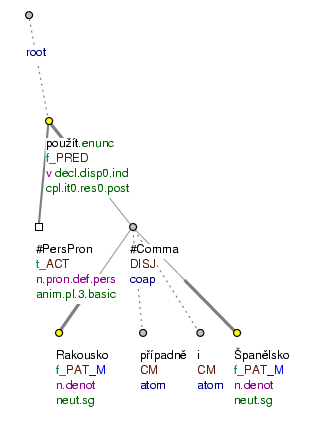
Použijí Rakousko, případně i Španělsko. (=lit. (They) will_use Austria, possibly also Spain)
Border with the CONJ functor. In cases of weak disjunction, the DISJ functor sometimes gets quite close to the CONJ functor (see Section 12.1.3, "CONJ"). In those cases where the propositions (modifications) are not mutually exclusive but they rather refer to several compatible alternatives, the conjunctions primarily carrying the DISJ meaning (nebo and či) are prefereably assigned the CONJ functor. These are cases in which the conjunction a can also be used instead. Cf.:
-
Posílají tam buď nemocné, nebo.
DISJzdravé. (=They send either ill, or healthy people there) -
Posílají tam nemocné nebo.
CONJ(= a) raněné. (=They send either ill, or (=and) injured people there)
-
Arabsky se mluví v Maroku, v Alžírsku nebo (= a).
CONJv Sýrii. (=Arabian is spoken in Morocco, Algeria or (=and) Syria)
Borders with the APPS, CONJ and CSQ functors. For more on the conjunction jinak (the border between the DISJ, CSQ and APPS functors) and the conjunction modifier respektive (the border between the functors DISJ, CONJ and APPS) see Section 12.2.1, "Borderline cases with the APPS functor".
Only a limited set of coordinating conjunctions can express gradation directly, without any conjunction modifiers. These are:
| ani | Stát neposkytne na nákup bytů žádné slevy, ani žádnou jinou finanční pomoc. (The state will not offer a discount, not even any other financial help) |
| natož | Nemůže se pohnout, natož vstát. (=He can't move, let alone get up) |
NB! Ani can also be a conjunction modifier; see Section 16.1.2, "Conjunction modifiers". The conjunction ani can also have the meaning of simple conjunction (after a negated verb). See also Section 12.1.7.1, "Borderline cases with the GRAD functor".
Basic connectives. The basic form used for expressing the GRAD meaning is a complex connective consisting of one of the basic conjunctions for CONJ or ADVS or just punctuation and a conjunction modifier (see Section 16.1.2, "Conjunction modifiers") that expresses the gradation.
The basic conjunctions forming the base of such complex connectives with the GRAD meaning are:
| a | Byl v tomto lidu oblíbený, a navíc vynikal krásou. (=He was popular, moreover he was very handsome) |
| ale | Věřím, že vytvoříme dobrou partu, která bude žít nejen tenisem a kvalifikací, ale posedí spolu i večer. (=...for which not only tenis is important, but also...) |
| ba | Závod plán splnil, ba dokonce jej překročil. (=The factory fulfilled the plan; it even overfulfilled it) |
| či | problém morální, či dokonce trestný (=ethical, or even legal problem) |
| nebo | Má podporu u voličů hlásících se k politickému středu, nebo dokonce k levici. (=He is supported by the centrists, or even the leftists) |
| nýbrž | Nestavíme jen domy, nýbrž dokonce budujeme i dětská hřiště. (=Not only do we build houses, we also build playgrounds) |
| punctuation | Má podporu u voličů hlásících se k politickému středu, dokonce i k levici. (=He is supported by the centrists, even the leftists) |
Example:
Má podporu u voličů hlásících se k politickému středu, nebo.GRAD dokonce.CM k levici. (=lit. (He) has support with voters belonging REFL to political centre or even to left) Fig. 7.70
Conjunction modifiers. Typical conjunction modifiers cooccuring with the GRAD functor are:
-
restrictors.
For example: vůbec, jen, zejména etc.
Example:
Jak mají vypadat vztahy mezi NKÚ a vládou, prý nezávisí jen.
CMna jejich libovůli, nýbrž.GRADjsou stanoveny zákonem. (=The relation between NKÚ and the government does not depend only on their willingness but it is established by a law) -
negating conjunction modifiers.
For example: ne, nikoli, ani etc.
Stát neposkytne na nákup bytů žádné slevy, [
#Comma.GRAD] dokonce.CMani.CMžádnou jinou finanční pomoc. (The state will not offer a discount, not even any other financial help) -
other conjunction modifiers.
dokonce Sedláček z voleje střílel nepřesně, Pěničkovu hlavičku chytil pohotový Šimůrka a v 71. minutě dokonce Horvát nastřelil tyč. (=S. wasn't shooting accurately, P.'s header was caught by Š. and in the 71st minute, H. even hit the goalpost) navíc Do roku 1989 měl tehdy státní podnik Sběrné suroviny v Praze 135 sběren, navíc rovnoměrně rozložených. (=...they had 135 collecting points, moreover equally spread) nadto Potřebujeme malý a jednoduchý stroj, aby by jej mohl obsluhovat jediný člověk, a nadto nespecialista. (=We need a simple machine such that a single person could operate it, moreover a non-professional) neřku-li Žádné velké, neřku-li systémové změny podnik nechystá. (=The company is not preparing any big changes, let alone systemic changes) jednak Jednak mu to usnadní práci, a především bota vypadá mnohem lépe. (=It will make his work easier, and most importantly the shoe looks much better then) NB! Jednak can be a conjunction modifier with the
GRADfunctor. However, primarily, it cooccurs with theCONJfunctor; if the proposition of the second clause is graded w.r.t. the first clause (esp. if this is made clear by an appropriate restrictor) the root node of the paratactic structure can also be assigned theGRADfunctor. For example:To je způsobeno jednak.
CMdodaným teplem, ale.GRADhlavně.CMcenami. (=This is caused by the heat supply but mainly by the prices)
Contextualizers. Coordinating conjunctions (with the GRAD functor) can be combined with other conjunction modifiers, too, esp. with so called contextualizers.
Examples:
V první vlně se sice.CM o kontrole těchto limitů hovořilo, [#Comma.GRAD] dokonce.CM se i.CM sledovaly, k žádným konkrétním sankcím se však nesáhlo. (=...people talked about the checks of the limits, they were even observed but..)
Laikovi se brzy zdá, že nejde o pouhý laciný švindl, nýbrž o naprosto legitimní problém, o jehož ošetření usiluje nejen.CM ekonomická věda, ale.GRAD i.CM politická praxe. (=...not only in theory but also in the political practice)
Ukázalo se tehdy, že nejen.CM metody práce s mladými lidmi, ale.GRAD také.CM samy výsledky jsou pro naše publikum sdělné a inspirativní. (=...not only the methods but also the results are inspiring)
Záměrem společnosti není [#Neg.CM] jen.CM stavět domy, ale.GRAD také.CM se postarat i.CM o sportovní vyžití. (=The intention is not only to build houses but also provide sports facilities)
Hlava Vatikánu nezastupuje [#Neg.CM] jen.CM tisícovku občanů, ale.GRAD je též.CM hlavou římskokatolické církve, která má stamiliony věřících po celém světě. (=The head of Vatican does not only represent one thousand of citizens but is also the head of the Church...)
Figure 7.70. The GRAD functor
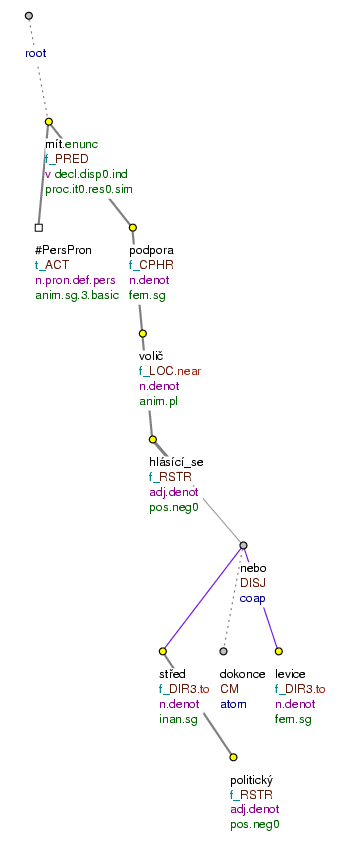
Má podporu u voličů hlásících se k politickému středu nebo dokonce k levici. (=lit. (He) has support with voters belonging REFL to political centre or even to left)
Border with the CONJ and ADVS functors. Only few (coordinating) connectives express the meaning of the GRAD functor unambiguously. Gradation is most often expressed by conjunctions the basic function of which it is to express the CONJ (i.e. a, i, ani) or ADVS meaning (ale, nýbrž), or else the connection is asyndetic. The GRAD functor is assigned especially if a conjunction modifier expressing gradation is part of the complex connective. Cf.:
-
dům a.
CONJzahrada (=the house and garden) -
dům a.
GRADnavíc.CMzahrada (=a house and morover a garden)
-
Ta by jednak.
CMupravovala kategorie výdajů a.CONJjednak.CMby omezovala moc státu v úpravách daňových zákonů. (=It would, on the one hand, regulate the costs and, on the other hand, it would put a limit on the power of the state...) -
Ta by jednak.
CMupravovala kategorie výdajů, a.GRADnavíc.CMby omezovala moc státu v úpravách daňových zákonů.(=It would, on the one hand, regulate the costs and, moreover, it would put a limit on the power of the state...)
If no conjunction modifier is used (esp. when the conjunction is ani) it is necessary to consider the relation between the propositions (modifications) carefully. Cf.:
-
Nechceme konkurovat stanici Prahaani.
CONJRadiožurnálu. (=We don't want to compete with either Praha or Radiožurnál) -
Tento jev není popsán v učebnicích, a.
GRADani.CMv odborné literatuře. (=This phenomenon is not described in textbooks and not even in technical literature) -
Tento jev není popsán v učebnicích, ani.
GRADv odborné literatuře. (=This phenomenon is not described in textbooks, not even in technical literature)
Basic connectives. The basic (coordinating) connectives with the meaning of the REAS functor are:
| neboť | Tento krok je pro národní hospodářství velice nebezpečný, neboť se do ekonomiky zanáší nesmírná džungle. (=This step is dangerous since it lets the jungle into our economy) |
| totiž | Provokace byly zjevně motivovány zlobou, všechny kocourkovské noviny si totiž do starosty s chutí rýply. (=The provocations were clearly motivated by anger, for all the newspapers were happy to pitch into the mayor) |
| vždyť | Úkol splníme, vždyť není obtížný. (=We'll fulfil the task, for it is not difficult) |
NB! The conjunction modifier totiž can be found with appositions, too (see Section 12.2.1, "Borderline cases with the APPS functor").
Conjunction modifiers. Coordinating conjunctions are often combined with other expressions that modify their meaning (see Section 16.1.2, "Conjunction modifiers"). With the REAS functor, the coordinating conjunctions mostly combine only with so called contextualizers.
Examples:
Úkol splníme, vždyť.REAS také.CM není obtížný. (=We'll fulfil the task, for it is not difficult) Fig. 7.71
Nemohu odejít, neboť.REAS ještě.CM nepřestalo pršet. (=I can't leave since it hasn't stopped raining yet)
Figure 7.71. The REAS functor
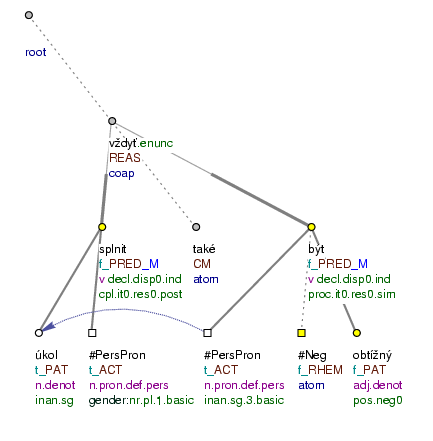
Úkol splníme, vždyť také není obtížný. (=lit. Task (we) will fulfil, since too not_is difficult)
Border with the CSQ functor. The REAS functor is to be distinguished from the CSQ functor, which also expresses a causal relation but viewed from the other side: the second proposition (modification) is the consequence of the first one. Cf.:
-
Pracoval nezodpovědně, a.
CSQproto.CMdostal výpověď (=He wasn't responsible in his work (and) therefore he was fired). -
Dostal výpověď, neboť.
REASpracoval nezodpovědně. (=He was fired, since he wasn't responsible)
Border with the CAUS functor. A cause or reason can also be expressed by a dependent clause; then, the effective root node of the clause is assigned the CAUS functor (see Section 5.2, "CAUS"). For the border between the REAS and CAUS functors, see Section 5.2.1, "Borderline cases with the CAUS functor ".
Border with the APPS functor. The connectives listed above are usually assigned only the REAS functor; only totiž can also be used with appositions. See also Section 12.2.1, "Borderline cases with the APPS functor".
